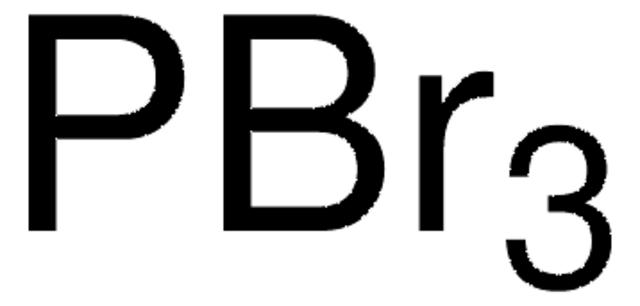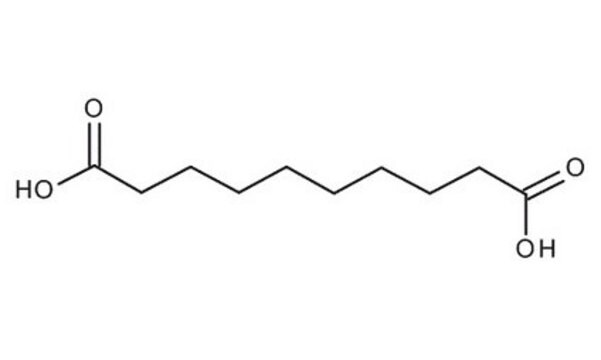177962
Undecanedioic acid
97%
Sinônimo(s):
1,9-Nonanedicarboxylic acid
Faça loginpara ver os preços organizacionais e de contrato
About This Item
Fórmula linear:
HOOC(CH2)9COOH
Número CAS:
Peso molecular:
216.27
Beilstein:
1780537
Número CE:
Número MDL:
Código UNSPSC:
12162002
ID de substância PubChem:
NACRES:
NA.23
Produtos recomendados
Ensaio
97%
pf
108-110 °C (lit.)
cadeia de caracteres SMILES
OC(=O)CCCCCCCCCC(O)=O
InChI
1S/C11H20O4/c12-10(13)8-6-4-2-1-3-5-7-9-11(14)15/h1-9H2,(H,12,13)(H,14,15)
chave InChI
LWBHHRRTOZQPDM-UHFFFAOYSA-N
Procurando produtos similares? Visita Guia de comparação de produtos
Categorias relacionadas
Palavra indicadora
Warning
Frases de perigo
Declarações de precaução
Classificações de perigo
Eye Irrit. 2
Código de classe de armazenamento
11 - Combustible Solids
Classe de risco de água (WGK)
WGK 3
Ponto de fulgor (°F)
Not applicable
Ponto de fulgor (°C)
Not applicable
Equipamento de proteção individual
dust mask type N95 (US), Eyeshields, Gloves
Escolha uma das versões mais recentes:
Já possui este produto?
Encontre a documentação dos produtos que você adquiriu recentemente na biblioteca de documentos.
Os clientes também visualizaram
M Matsumoto et al.
Biomedical & environmental mass spectrometry, 19(3), 171-175 (1990-03-01)
Urine from patients with calcium-4-(2,4-dihydroxy-3,3-dimethylbutyramido) butyrate hemihydrate (hopantenate) therapy during episodes of Reye's-like syndrome was found to contain a number of unusual dicarboxylic acids in high concentrations; odd- and even-numbered medium-chain dicarboxylic acids, alpha-hydroxydicarboxylic acids and beta-hydroxydicarboxylic acids. The abnormal
M Claire et al.
Connective tissue research, 4(2), 61-71 (1976-01-01)
Macroscopically lesion-free parts of human aortas with no or light lesions (group I) and advanced atherosclerotic lesions (group II) were submitted to a series of successive extractions in order to "solubilize" all the macromolecular components of the arterial wall ("chemical
Shuang Yang et al.
Journal of agricultural and food chemistry, 64(48), 9237-9245 (2016-12-10)
The current study aimed to investigate whether quercetin plays a protective role in acrylamide (AA)-induced toxicity using a metabolomics approach. Rats were randomly divided into groups as follows: control, treated with AA [5 mg/kg body weight (bw)], treated with different
Fei Li et al.
Journal of proteome research, 14(4), 1937-1946 (2015-02-26)
Colon cancer is the most common cancer and the third leading cause of cancer mortality in humans. Using mass spectrometry-based metabolomics, the current study revealed the accumulation of four uremic toxins (cresol sulfate, cresol glucuronide, indoxyl sulfate, and phenyl sulfate)
Xiaoling Zang et al.
Journal of proteome research, 13(7), 3444-3454 (2014-06-13)
Prostate cancer (PCa) is the second leading cause of cancer-related mortality in men. The prevalent diagnosis method is based on the serum prostate-specific antigen (PSA) screening test, which suffers from low specificity, overdiagnosis, and overtreatment. In this work, untargeted metabolomic
Nossa equipe de cientistas tem experiência em todas as áreas de pesquisa, incluindo Life Sciences, ciência de materiais, síntese química, cromatografia, química analítica e muitas outras.
Entre em contato com a assistência técnica











